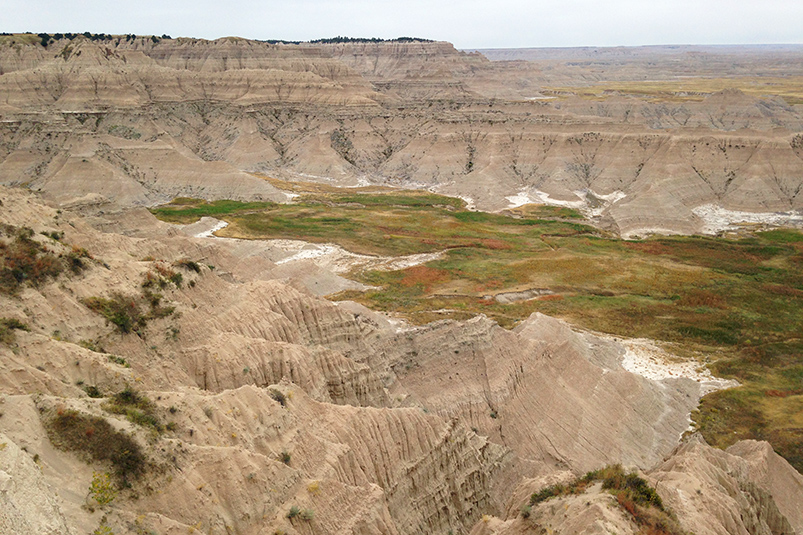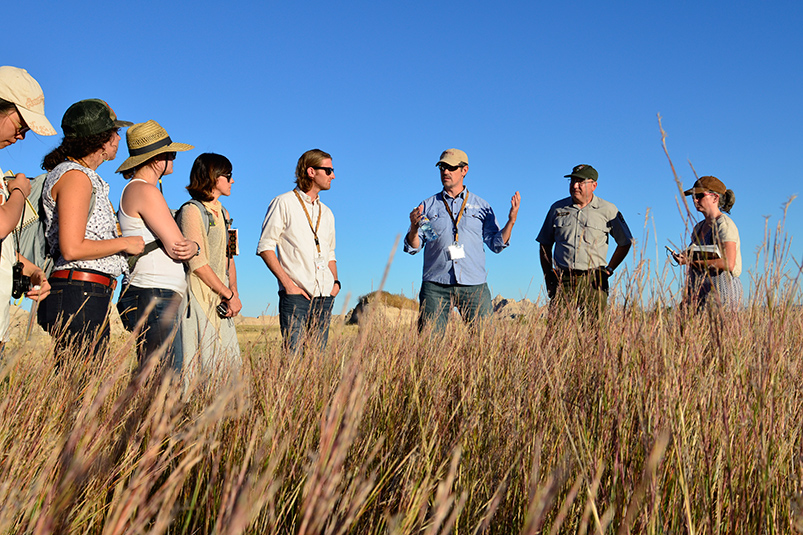Bettering Badlands

The terrain at Badlands National Park, where bison and other wildlife enjoy thousands of acres of mixed-grass prairie. PHOTO Jonathan Garner
WHEN SIX WILDFLOWER CENTER STAFF TRAVELED TO SOUTH DAKOTA LAST FALL, they joined students in surveying the stunning sites at Badlands National Park, including rocky spires, bighorn sheep, prehistoric fossils and immense stretches of prairie. Center experts were there helping School of Architecture faculty from The University of Texas at Austin teach a dozen architecture students as part of a studio class formed to help the National Park service (NPS) revitalize the historic development and landscape at Badlands’ headquarters.
As part of the class, the team visited with park staff and local Lakota Sioux members. They also spent five days touring the Cedar Pass headquarters, including a visitor center illustrating fragments of Badlands’ story and a lodge and other buildings added piecemeal since the 1930s. Those buildings rest in maintained lawns rather than the iconic, mixed-grass prairie blanketing windswept vistas in less-trafficked parts of the park.
“As our agency celebrates its centennial in 2016, this project exemplifies our engagement with the next generation,” says Patty Trap, NPS deputy regional director for the Midwest. “These graduate students have brought new thinking about the management of historic places within larger natural ecosystems to help ensure Cedar Pass is preserved so future generations can enjoy this amazing place.”

Matthew O’Toole (center), interim director of the Center’s research and consulting program, talks with graduate students Amy Grossman and Warner Cook (far left), Center colleagues Michelle Bright, Jonathan Garner and Michelle Bertelsen, and Dr. Milt Haar from NPS (immediate right of O’Toole). PHOTO John Hart Asher
South Dakota’s extreme weather doesn’t help. Severe storms sometimes pulverize rocky plateaus near buildings, creating streams of sediment and causing flooding. Meanwhile, dozens of invasive species, such as garlic mustard and knapweeds, can swamp out sightings of natives such as hopi tea (Thelesperma megapotamicum) and hairy clematis (Clematis hirsutissima).
The good news? With guidance from Center experts and university faculty, the students devised straightforward enhancements such as replacing monoculture lawns with prairie. They also created a modernized design concept for the visitor center that would better showcase the cultural value of the 242,756-acre park. The students’ design would allow guests learning about the landscape to immediately step into the prairie from a nearby doorway.
“That prairie will naturally provide an improved sustainability aspect to the landscape that dovetails with federal landscape guidelines and is supported by the sustainable sites initiative,” says Matthew O’Toole, the Center’s interim director of research and consulting, “and it would become part of telling a more meaningful, larger story about this national treasure.”

